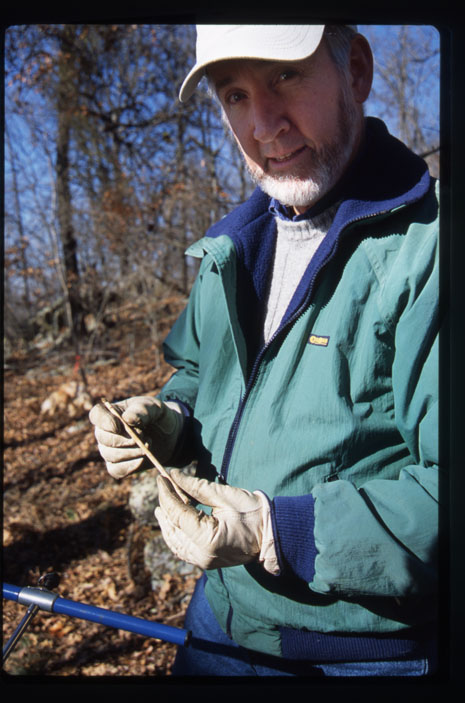
FAYETTEVILLE, Ark. – Dendrochronologists have shown that tree-ring data produce a remarkably accurate history of droughts and other climate changes. Combined with reliable drought indices and historical descriptions of climate conditions, dendrochronology – the technique of dating events and environmental change by relying on characteristic patterns of tree-ring growth – can provide a climate perspective on important events such as large-scale human migration and even the rise and fall of entire civilizations.
A research team, including University of Arkansas Distinguished Professor and dendrochronologist David Stahle and Ewing Research Professor Edward Cook of Columbia University, used more than 1,400 climate-sensitive tree-ring chronologies from multiple tree species across North America to reconstruct the Palmer drought severity index (PDSI), a widely used soil moisture index. Stahle presented his research Friday, Feb. 15, in a symposium on “U.S. Climate and Weather Extremes: Past, Present, and Future,” during the American Association for the Advancement of Science annual meeting in Boston. He also participated in a panel discussion with other climate experts.
The Palmer drought severity index is based on instrumental temperature and precipitation data dating back to 1895. Stahle and his colleagues inserted the index between fixed points on a grid covering most of North America. Their tree-ring reconstructions cover the same geographic area but extend back to 800 A.D.
Stahle wanted to examine the reconstructed indices to test the accuracy of the records and to see if there were any patterns related to drought and other climate changes. The findings were dramatic.
“Comparisons of reconstructed PDSI with instrumentally measured PDSI during the 20th century document the remarkable accuracy with which the tree-ring data reproduce the spatial pattern and intensity of observed drought at annual and decadal time scales, including the Dust Bowl drought of the 1930s,” Stahle said.
The data also confirmed historical descriptions of climate conditions prior to the modern era of instrumentation for weather and climate measurements. For these comparisons, the researchers relied on accounts from Zebulon Pike’s 1806-1807 expedition and from Stephen H. Long’s 1820 exploration. Both expeditions described extremely dry conditions across much of the Great Plains and Rocky Mountains.
The researchers analyzed the reconstructions and found a pattern of droughts over the past few centuries similar to the 2011 drought centered over Texas and the Southern Plains as well as the 2012 Corn Belt drought.
“Both of these droughts have precedents in the centuries-long tree-ring reconstructions,” Stahle said. “In fact, the tree-ring data document drought anomalies in prehistory with a similar severity and spatial impact that persisted for two to three years. Severe drought over the Corn Belt and southern Great Plains are likely to recur, especially with continued warming over the United States.”
The tree-ring reconstructions of the Palmer index indicated that the Great Pueblo Drought, which occurred from 1276 to 1297 and may have contributed to the abandonment of the northern Colorado Plateau by the ancient Pueblo, affected a larger geographic area than originally thought. The findings indicated that this drought covered the entire southwestern United States and included drought in both the winter and early growing season.
For more than a decade, Stahle has taken core samples from trees and examined the chronology of their rings to help explain the societal impact of drought and other climate changes. Specifically, his research has added rich information to explanations about the migration of North America’s indigenous people and the demise of Mesoamerican civilization.
A recently published 1,238-year-long tree-ring chronology, the longest and most accurate of its kind for Mesoamerica, was the first to reconstruct the climate of pre-colonial Mexico on an annual basis for more than a millennium. That study identified four ancient megadroughts and their exact years. Previous research found large and epic droughts over North America during the 8th and 16th centuries.
Topics
Contacts
David Stahle, Distinguished Professor, geosciences
J. William Fulbright College of Arts and Sciences
479-575-3703, dstahle@uark.edu
Matt McGowan, science and research communications officer
University Relations
479-575-4246,
dmcgowa@uark.edu